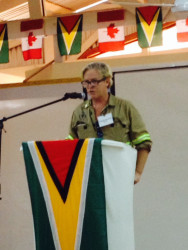Nineteen years after the first foray into the Cuyuni region in search for gold and US$249 million in capital costs, Guyana Goldfields Inc (GGI) is now set for production of 3.29 million ounces of the precious metal over 17 years which will see at least 500 jobs and projected corporate income tax to the economy of US$509 million.
With gold prices having slid dramatically from the high of over US$1,800, the US$1,123 price per ounce yesterday still gives the company’s Aurora Gold Mine a tidy margin. At Tuesday’s commissioning of the first gold pour in the Cuyuni/Mazaruni region, financials supplied by the company showed that it is projecting all-in costs of between US$749 to US$779 per ounce of gold recovered. Oil has also been factored into the financials at US$95 per barrel, way above the price at present following the collapse of the oil price.
In addition to the 500 permanent jobs created – 700 Guyanese were employed in the initial 1,200 during the construction phase – the company is also paying up to 8% royalty on the gold retrieved. The 8% prevails for gold priced over US$1,000 while 5% will be applied for gold under US$1,000. If the average minimum price of gold was US$1,000 over the mine life, the country would stand to gain US$263 million – less however than the projected corporate income tax. As a comparison, Omai Gold Mines Limited paid royalty of 5% but no corporate income tax. The GGI venture is also projected to contribute US$67 million in payroll taxes and US$43 million in excise taxes.
GGI is also expected to be a large purchaser of local services such as in aviation and other areas such as the food sector.

Speaking on Tuesday in a hall at the site decorated for the occasion, the founder of the company Patrick Sheridan Jr, 52, recounted the earliest and humble origins of the company. With his mother in the audience, Sheridan told of the hundreds of sometimes hair-raising boat trips up the Cuyuni River beginning in 1996 in the quest for gold. Today, he quipped, employees of the company will be flown to work – no boats – two weeks in and one week out.
He lauded the services of several Guyanese who stuck with him through the early days including Cornell King who he said built the first Aurora camp and could pitch one in any place. He said that King’s contribution can never be over-estimated. Noting that 1,200 boreholes were drilled in the Aurora area before the company hit it big at Rory’s Knoll, Sheridan said that at that time there was little drilling capacity and he complimented the work that was done then by Carib Drilling.
While the mine life is projected at 17 years for 3.29 million ounces, Sheridan noted that the area has an estimated eight million ounces – 75% of which is in Rory’s Knoll, named for the person who discovered it, Rory Calhoun.
Adverting to the jobs created for Guyanese, Sheridan said it will perhaps be the most important legacy of the company.
Earlier, CEO and President of the company, Scott Caldwell declared that the mine had been built to the highest technological and environmental standards and offered a “great platform for growth.” He cautioned that there was still a lot of hard work to come and added “stay tuned for great things to happen.”
Gold will be retrieved via two methods once the rocks are pulverized: gravity separation and by the use of cyanide. A slurry is created with the cyanide in a process known as gold cyanidation. The gold dissolves in aqueous solutions of cyanide. Cyanide use for gold extraction has had a negative image here after a tailings pond at Omai Gold Mines Limited broke away in 1995 and contaminated the Omai and the Essequibo rivers with poisonous effluent.
In October 2014, Sheridan at a mining conference here assured that there is no such risk.
“The cyanide is destroyed before we ever discharge into the dam so if there is no risk of a cyanide spill…,” Caldwell said. “I have promised that when we are up and running I will drink the tailings water,” he added.
Stabroek News had been told that that the International Finance Corporation (IFC) made it a mandatory requirement that the cyanide destruction facility of GGI meets quality assurance and quality control standards before monies were loaned to company for the investment. The company’s tailings dam is also expected to meet rigorous safety standards. To protect from any flooding from the Cuyuni River which borders the mine site, the company has built a levy which caters for a 10,000-year flood event.
The top 10 shareholders in GGI are the hedge fund, The Baupost Group at 19.8%; investment firm, Franklin Resources (Templeton) at 8.6%; mutual fund, Van Eck at 7.8%; the IFC (World Bank Group) at 4.6%; Patrick Sheridan Jr (Founder) at 4.3%; Sun Valley Gold at 3.2% and Fidelity Investments at 2.4%.
Tuesday’s opening was addressed by President David Granger and featured several cultural presentations including one depicting the travails of travelling by boat on the river. Guests were treated to a buffet lunch after which many took the opportunity to be photographed with the company’s first bar of gold. Dozens of the company employees also took the opportunity to have photographs taken with President Granger.




